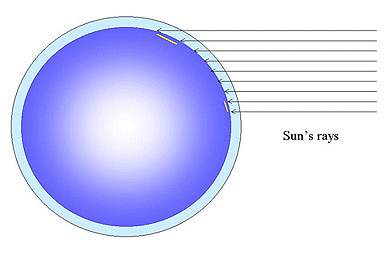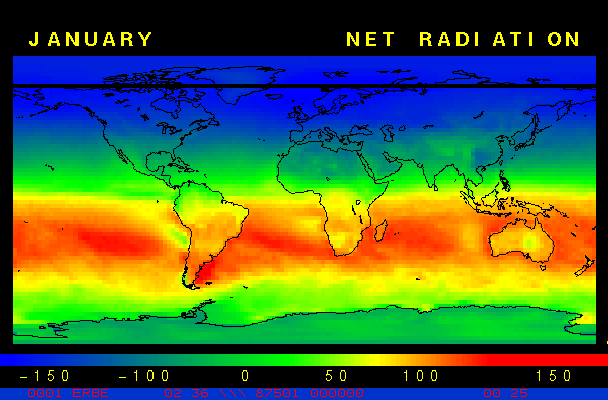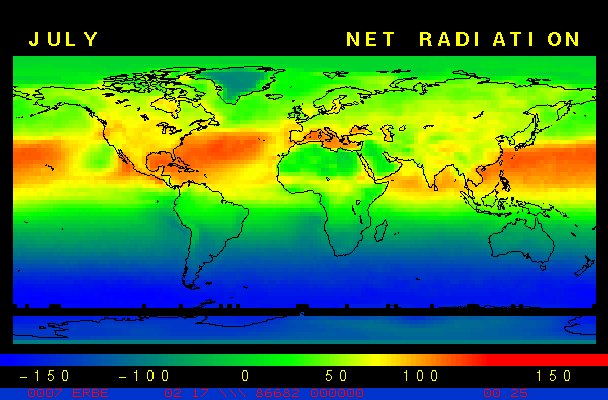Date: Mon Jun 6 14:40:26 2005
Posted By: Ken Harding, Science and Operations Officer, National Weather Service
Area of science: Earth Sciences
ID: 1117827553.Es
Message:
Many factors affect temperatures on the earth. Some of the most important
are: location, nearness to oceans, land cover, and weather patterns. I’ll
speak to the extreme cold at the South Pole, but most of the arguments hold
for the North Pole as well.
Location: Over one year, every point on earth gets the same amount of
daylight. Based on your location, it changes with the seasons. In the
tropics, the day length doesn’t change very much from summer to winter. For
example, at Christmas Island in the Pacific Ocean (only about 1.5 degrees
north of the Equator), the longest day of the year is June 15 with a
sunrise of 5:53 AM and sunset at 6:08 PM. The shortest day of the year is
January 2 with a sunrise at 6:04 AM and a sunset at 6:04 PM – only 15
minutes difference between the longest and shortest day of the year. Thus,
this area receives nearly constant sunshine…no great differences in day
length to allow great temperature swings.
At the exact South Pole, the sun rises on March 21, and sets on Sep 21.
Only one ‘day’ per year, with day and night each lasting 6 months. Thus,
when it’s dark for so long, it can get very cold.
(Source : http://www.usno.navy.mil/
 Another factor of location is called solar path length. The sunlight that
shines on the equator shines nearly straight down, while the sunlight that
shines on the South Pole has to go through relatively more atmosphere,
which filters out more of the energy.
Another factor of location is called solar path length. The sunlight that
shines on the equator shines nearly straight down, while the sunlight that
shines on the South Pole has to go through relatively more atmosphere,
which filters out more of the energy.
Nearness to oceans: Generally, oceans act to prevent big swings in
temperatures. For example, Seattle Washington is about as far north of the
equator as Grand Forks, North Dakota. The average low temperature in
January in Seattle is 34 degrees, while in Grand Forks, the average low in
January is 4 below zero. Most of this difference is due to the Pacific
Ocean providing relatively warm water to keep Seattle warm. At the South
Pole, the ocean is very far away, so there is no relatively ‘warm’ water to
keep temperatures from falling.
Land cover: The nature of the land’s surface affects how much of the sun’s
energy gets absorbed (making it warm) or reflected (which keeps it from
being warm). If the ground id dirt, water, trees, cities, etc., then plenty
of solar energy is absorbed. At the South Pole, the snow and ice reflect
nearly 100% of all the sun’s energy back into space. Thus, when the sun
does shine, it doesn’t warm up anything, and it keeps getting colder.
The following figure shows the net solar radiation received across the
earth in January. This is the sum of sunlight in minus heat out. Notice the
South Pole has a net value around zero which means no net warming by the
sun. This is in the middle of summer! In the winter, the sun doesn’t shine,
so the net is negative, and it just gets colder.


Finally, weather patterns affect extreme temperatures. Weather patterns are
somewhat dependant on the above factors. Very cloudy places tend to be
warmer in the winter as the clouds act like a blanket to keep heat close to
the ground. At the South Pole, clouds actually increase the temperature.
However, the atmosphere is so cold, and dry, that there are often not many
clouds, and it stays very cold.
The
coldest temperature ever recorded on the earth’s surface was at Vostok,
Antarctica in August 1960, with a reading of -129 degrees Fahrenheit!
Here are some other web links that contain good information about the
earth’s energy budget and how it affects temperature:
http://www.uwsp.edu/geo/faculty/ritter/geog101/textbook/energy/outline.html
http://cimss.ssec.wisc.edu/wxwise/homerbe.html
Ken Harding
National Weather Service
Current Queue |
Current Queue for Earth Sciences |
Earth Sciences archives
Try the links in the MadSci Library for more information on Earth Sciences.
MadSci Home | Information |
Search |
Random Knowledge Generator |
MadSci Archives |
Mad Library | MAD Labs |
MAD FAQs |
Ask a ? |
Join Us! |
Help Support MadSci
MadSci Network,
webadmin@madsci.org
© 1995-2005. All rights reserved.
 Another factor of location is called solar path length. The sunlight that
shines on the equator shines nearly straight down, while the sunlight that
shines on the South Pole has to go through relatively more atmosphere,
which filters out more of the energy.
Another factor of location is called solar path length. The sunlight that
shines on the equator shines nearly straight down, while the sunlight that
shines on the South Pole has to go through relatively more atmosphere,
which filters out more of the energy.

